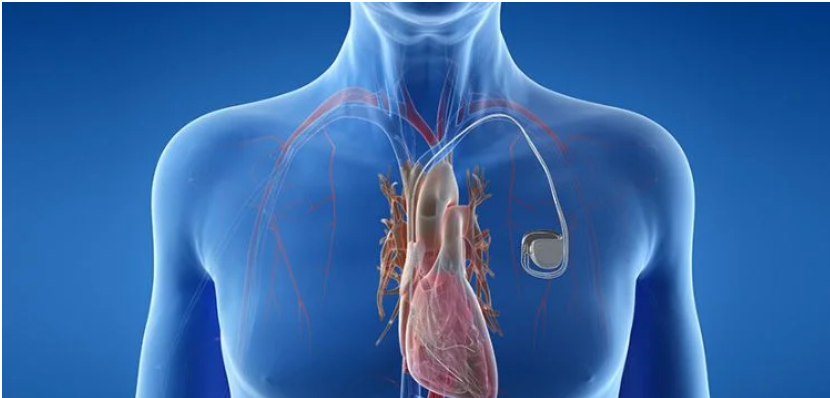Pacemaker Surgery Cost In Delhi | Dr. Dinesh Kumar Mittal

A normal, healthy heart has internal pacemakers that regulate its rhythmic contractions. Pacemakers play a critical role in ensuring a steady and consistent heartbeat. However, irregular heart rhythms can arise when the heart’s natural pacemakers fail to maintain a constant rhythm. Pacemakers have become essential medical devices, enabling patients to live normally. They are particularly beneficial for individuals with irregular, slow, or rapid heart rhythms.
Dr. Dinesh Kumar Mittal, a distinguished cardiologist, has significantly contributed to the field of pacemakers. His research and expertise have advanced pacemaker technology, ensuring these devices effectively restore and maintain heart rhythms. Dr. Mittal’s work underscores their critical role in modern cardiology, helping patients with irregular, slow, or rapid heart rhythms lead normal lives. His dedication to enhancing these life-saving devices continues to improve the quality of life for countless individuals worldwide.
This thorough guide will dig into the world of pacemakers, learning about what they are, how they operate, the numerous types available, the problems they may cure, the signals that suggest the need for a pacemaker, and the various implantation procedures. In addition, it will discuss the cost of pacemaker installation in India, a country noted for its affordability and heart care competence.
What is a Pacemaker?
A pacemaker is a small, battery-powered medical device generally placed into a patient’s chest or belly. It is made up of two main parts:
- Pulse Generator: This component provides electricity to the pacemaker. It sends electrical signals to the heart to control its beat.
- Tiny Computer: The pacemaker includes a small computer that continually monitors the heart’s electrical activity and changes its pacing as needed.
Leads, or electrodes, are tiny wires connected to the heart muscles through veins. These leads are in charge of transferring electrical impulses to the pulse generator. When the pacemaker recognizes aberrant cardiac activity, it delivers precisely timed electrical shocks to return the heart to a normal rhythm. Depending on the kind of pacemaker, it may contain one to three leads, each performing a distinct role.
What are the Types of Pacemakers?
Their specific cardiac condition and symptoms determine the type of pacemaker indicated for a patient. The three primary types of pacemakers are:
- Single-Chamber Pacemakers: These devices feature a single lead that links the pulse generator to a single chamber of the heart. They are frequently utilized when only one section of the heart requires pacing.
- Dual Chamber Pacemakers: Dual chamber pacemakers have two leads that link to both the right and left sides of the heart. This pacemaker type enables better-synchronized pacing of both chambers, more closely imitating the heart’s regular beat.
- Biventricular Pacemakers: These are the most sophisticated pacemakers, with three leads. They are generally used to treat progressive heart failure by synchronizing the pacing of both ventricles, enhancing the overall efficiency of the heart.
What Conditions are Treated with Pacemakers?
Pacemakers are adaptable medical devices that treat a variety of cardiac diseases, including:
- Bradyarrhythmias: These slow cardiac rhythms can cause weariness, dizziness, and fainting symptoms.
- Heart Failure: Pacemakers can help optimize heart function, especially in situations of heart failure.
- Syncope: Fainting or syncope may result from irregular cardiac rhythms, and pacemakers can help regulate and manage these episodes.
- Hypertrophic Cardiomyopathy: It is a condition characterized by the abnormal thickening of the heart muscle.
Dr. Mittal effectively utilizes pacemakers to treat various cardiac conditions. His expertise extends to addressing bradyarrhythmias, which can lead to fatigue and fainting. He has effectively improved heart function in patients, successfully addressed syncope associated with irregular heart rhythms, and effectively managed hypertrophic cardiomyopathy characterized by thickening of the heart muscle.
Patients who have benefited from Dr. Mittal’s expertise in utilizing pacemakers for cardiac conditions have shared their experiences. One patient expressed profound gratitude, stating, “Dr. Mittal’s pacemaker treatment transformed my life. I no longer experience the fatigue and fainting spells that once plagued me due to bradyarrhythmia. His skillful approach to managing heart failure has renewed my energy and hope. I am truly thankful for his exceptional care in treating my cardiac condition.”
Signs Indicating the Need for a Pacemaker
Recognizing the need for a pacemaker can be difficult since many persons with cardiovascular difficulties do not immediately recognize their symptoms. Dr. Mittal lists the following symptoms as indicators of the necessity for a pacemaker:
- Fatigue: Excessive and unexplained exhaustion may indicate an abnormal heart rhythm.
- Fainting: Unexplained episodes of fainting may be attributed to irregular heartbeats.
- Dizziness: Frequent feelings of dizziness or lightheadedness could signal a potential issue with your cardiac rhythm.
- Exercise Limitations: If you encounter increased difficulty in engaging in physical activities due to palpitations or breathlessness, you should seek medical evaluation.
Consulting a cardiologist is recommended if you experience any of these symptoms, as they can determine whether a pacemaker is the appropriate treatment option.
What are the Methods of Pacemaker Implantation?
Pacemakers are implanted using one of two methods: endocardial or epicardial.
- Endocardial Approach: This is the most frequent pacemaker insertion procedure. Local anesthesia is used to numb the region during this treatment. The pacemaker and leads are placed through a chest incision. An X-ray machine is used to guide the threading of the leads into veins.
- Epicardial method: In pediatric instances, the epicardial method is widely used. To put the patient to sleep, general anesthesia is administered. The pacemaker is implanted beneath the skin in the belly using this procedure.
The patient’s medical condition and demands dictate the strategy used. Both surgeries typically last 1 to 3 hours, and patients are encouraged to stay in the hospital overnight.
Following implantation, patients are frequently asked to wear an arm sling for 24 hours to help heal.
Dr. Mittal has employed both endocardial and epicardial pacemaker implantation methods to treat patients, depending on their medical condition and specific needs. His extensive experience with these techniques has enabled him to effectively provide cardiac care and improve the quality of life for numerous individuals.
Price of Pacemakers in India
India has emerged as a center for low-cost, high-quality medical treatment, including heart surgeries. The cost of heart surgery in India is much lower than in many other nations. Patients worldwide frequently pick India for pacemaker implantation because of its low cost and availability of superior medical facilities.
The cost of pacemaker implantation in India might vary based on numerous factors, including:
- The transplant technique
- Sedation or anesthesia type
- Incision site (chest or abdomen)
- The patient’s overall health state
According to the most recent available statistics, the cost of a pacemaker transplant in India ranges between $2,000 and $3,500, excluding the cost of the pacemaker itself. The pacemaker’s kind and quality can impact the total cost. As a result, the overall cost of pacemaker implantation in India often ranges between $4,000 and $5,600.
What is the Cost of Pacemakers Surgery in India?
Pacemaker surgery costs in India exhibit a range: the minimum expense starts at INR Rs. 40,000, averages around INR Rs. 50,000, and can reach up to INR Rs. 55,000. When converted, this reflects an average cost of USD 570 to USD 780. Conversely, the same surgery in the US typically spans from USD 9,000 to USD 30,000. Across major Indian cities like Bangalore, Delhi, Mumbai, Gurgaon, Chennai, Hyderabad, and Pune, the cost remains consistent at Rs. 41,000 to Rs. 55,000, ensuring uniformity in pricing for this crucial cardiac procedure. However, The cost may vary depending on the techniques used in CABG procedures within the region.
Conclusion
Pacemakers are transformative devices that effectively manage irregular heart rhythms, significantly enhancing patients’ quality of life. If you’re encountering symptoms such as fatigue, dizziness, or fainting, seeking consultation with a cardiologist about potential pacemaker placement is crucial.
India, known for affordable, high-quality cardiac care, with skilled surgeons and advanced facilities, is an excellent option for pacemaker implantation, showcasing excellence in accessible healthcare.
Frequently Asked Questions (FAQs)
1. What is the procedure for pacemaker implantation?
Pacemakers are surgically implanted through endocardial placement using veins or epicardial placement beneath the skin.
2. What are the indications that suggest the requirement for a pacemaker?
Signs include fatigue, fainting, dizziness, and exercise limitations due to heart rhythm abnormalities.
3. How long does a typical pacemaker implantation procedure take?
A pacemaker implantation procedure typically lasts between 1 to 3 hours, depending on the patient’s specific condition and the chosen implantation method.
4. Are there any lifestyle restrictions for individuals with pacemakers?
While individuals with pacemakers can lead normal lives, they may need to avoid strong magnetic fields and certain activities, so it’s important to discuss lifestyle considerations with their healthcare provider.
5. How much does pacemaker implantation cost in India?
The cost varies but ranges from $4,000 to $5,600, excluding the pacemaker cost, making India an affordable option for this procedure.
